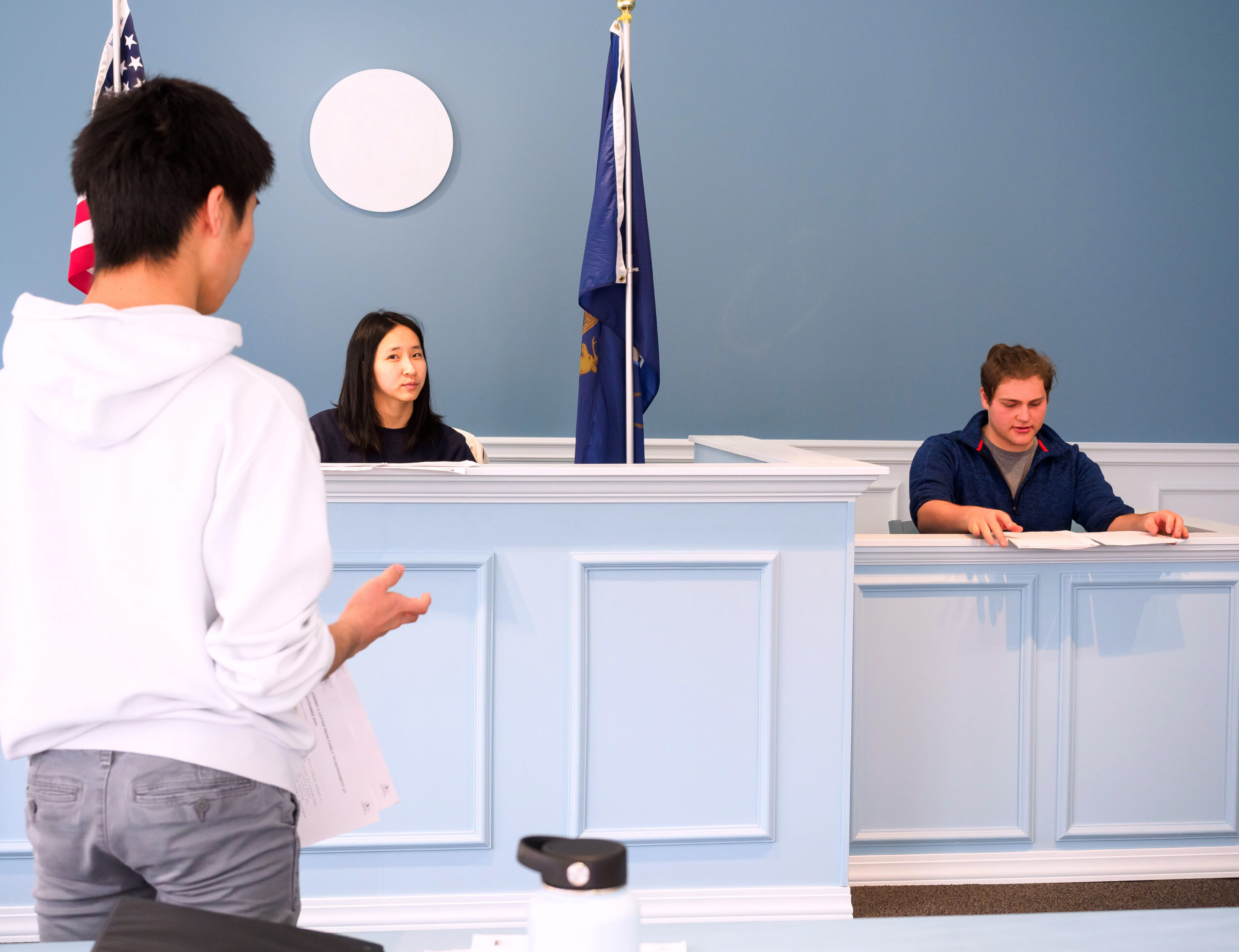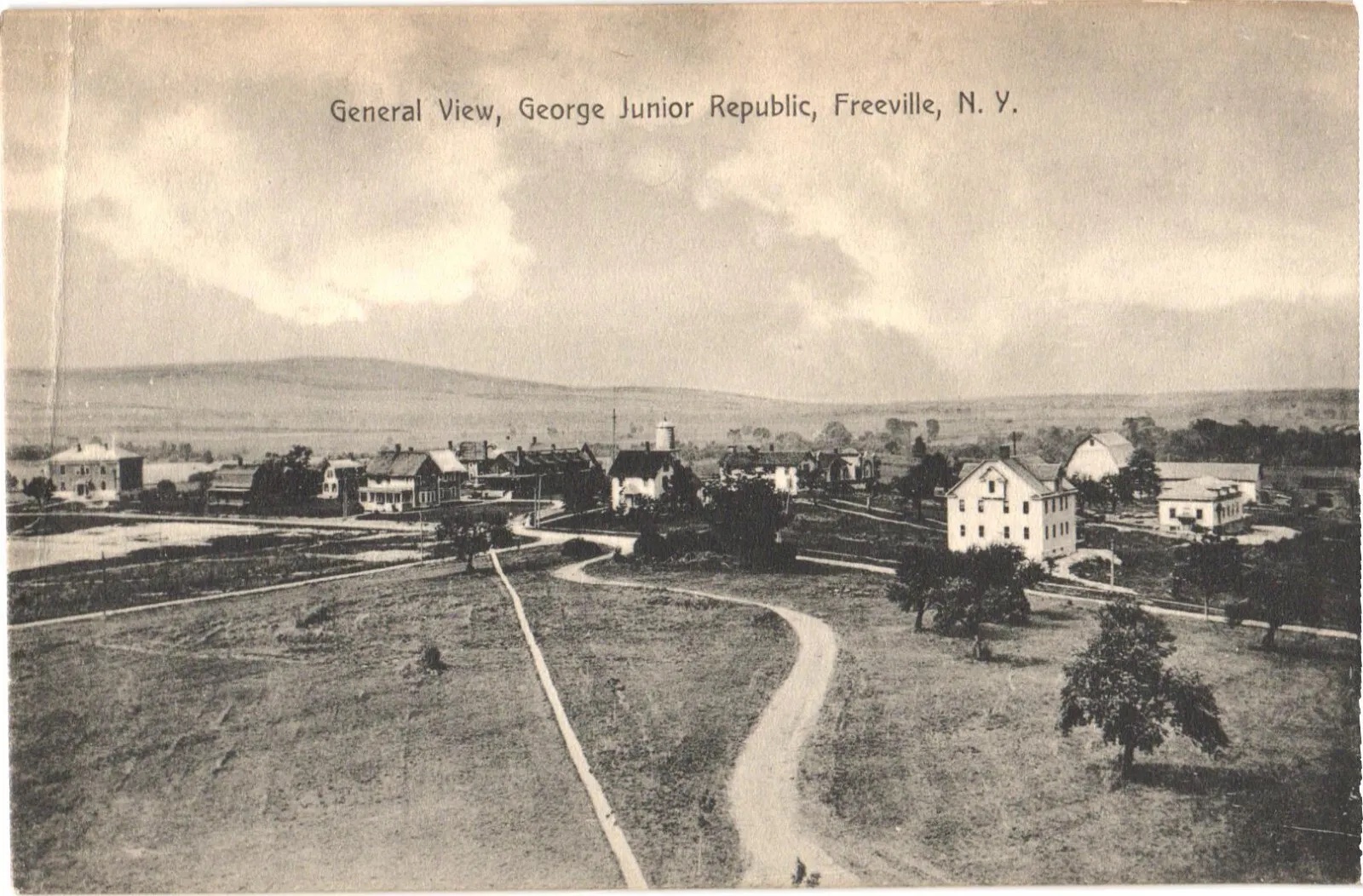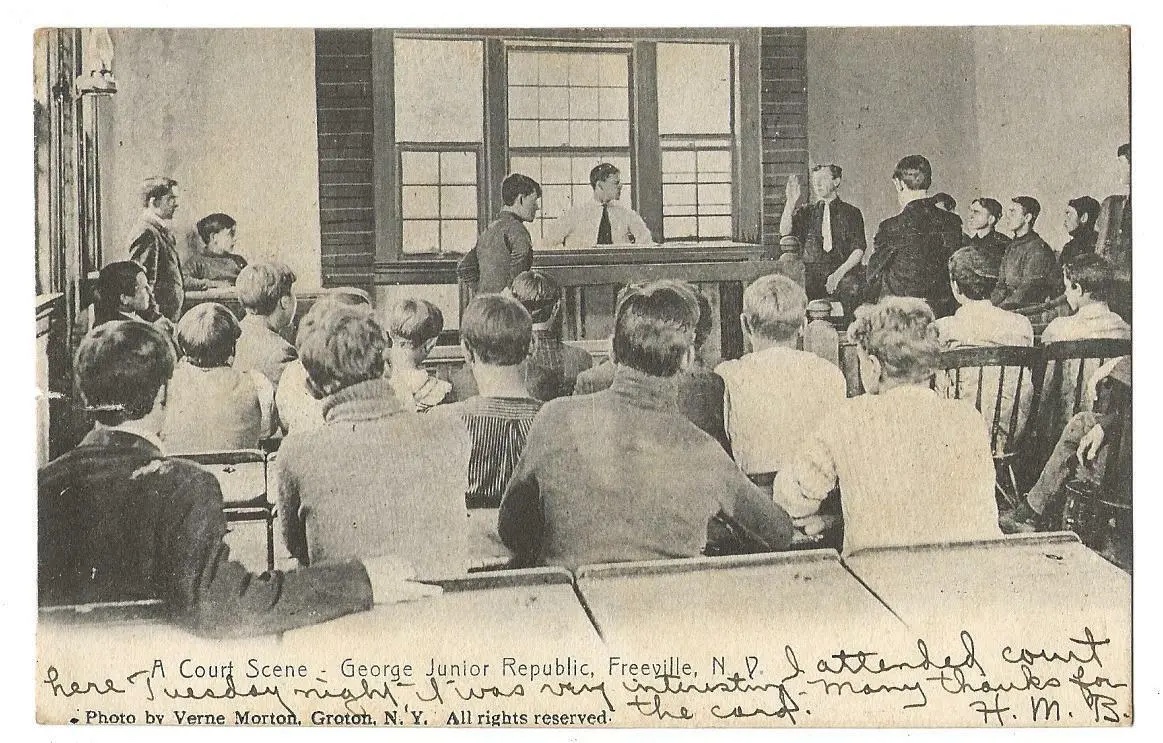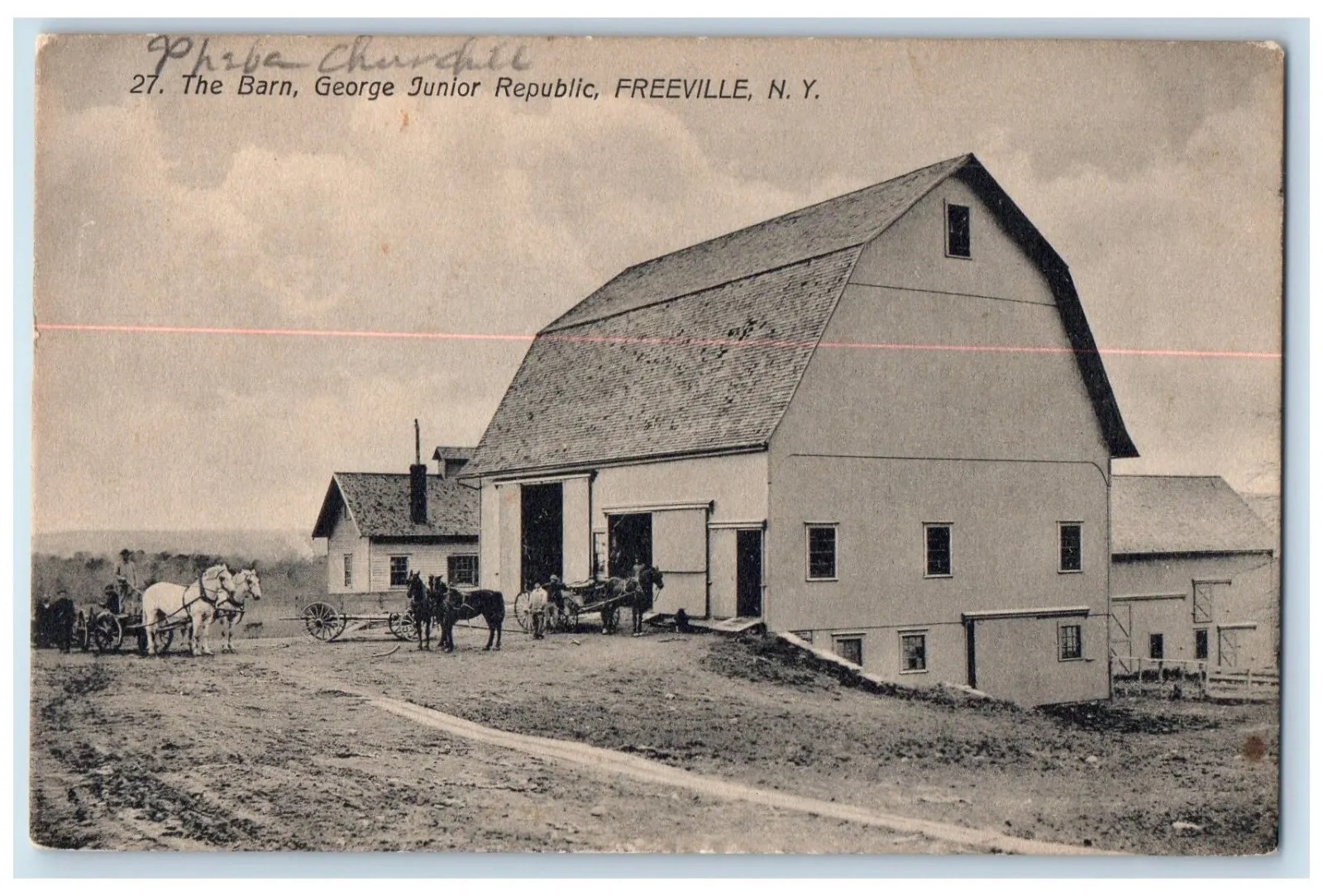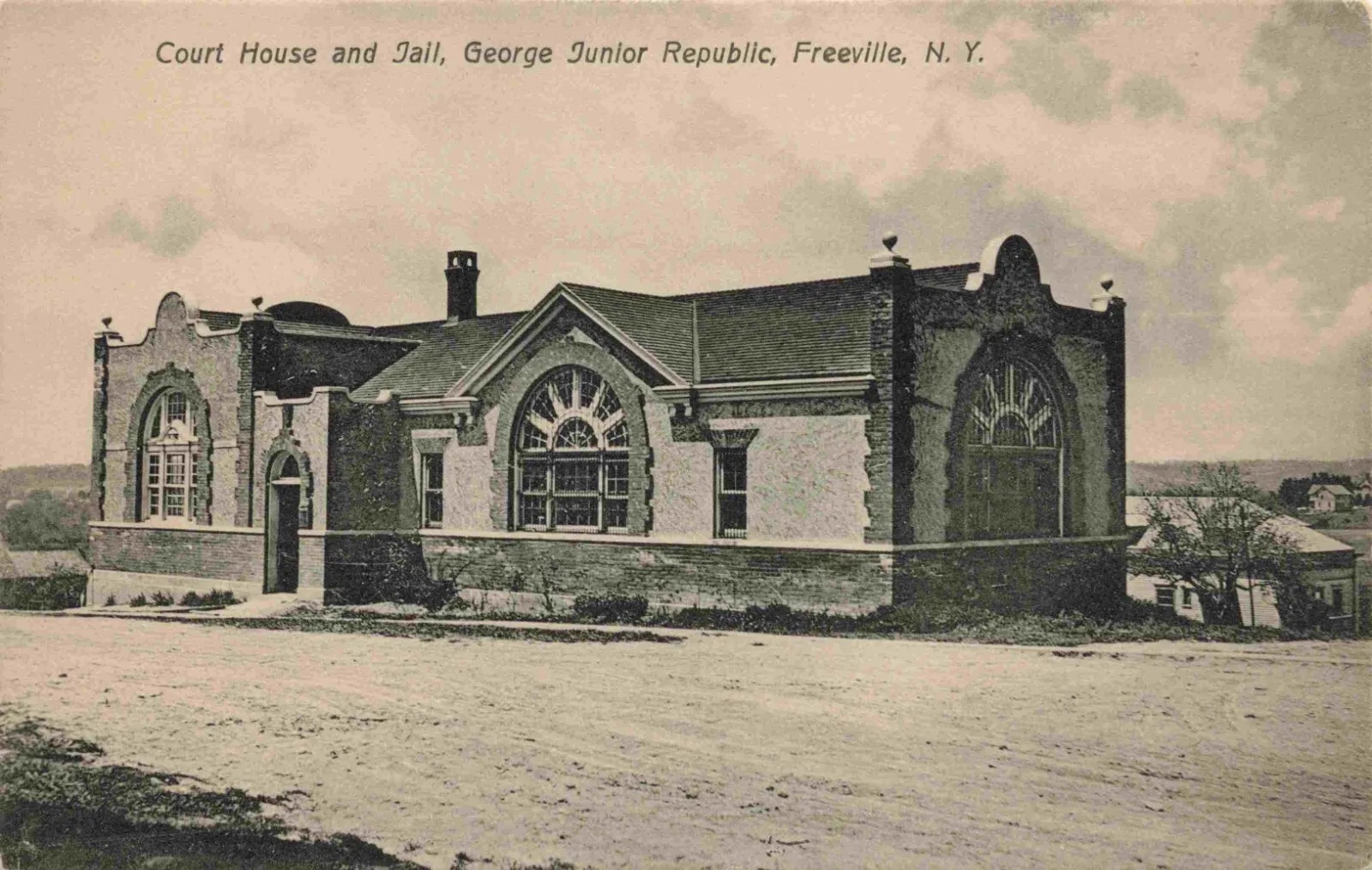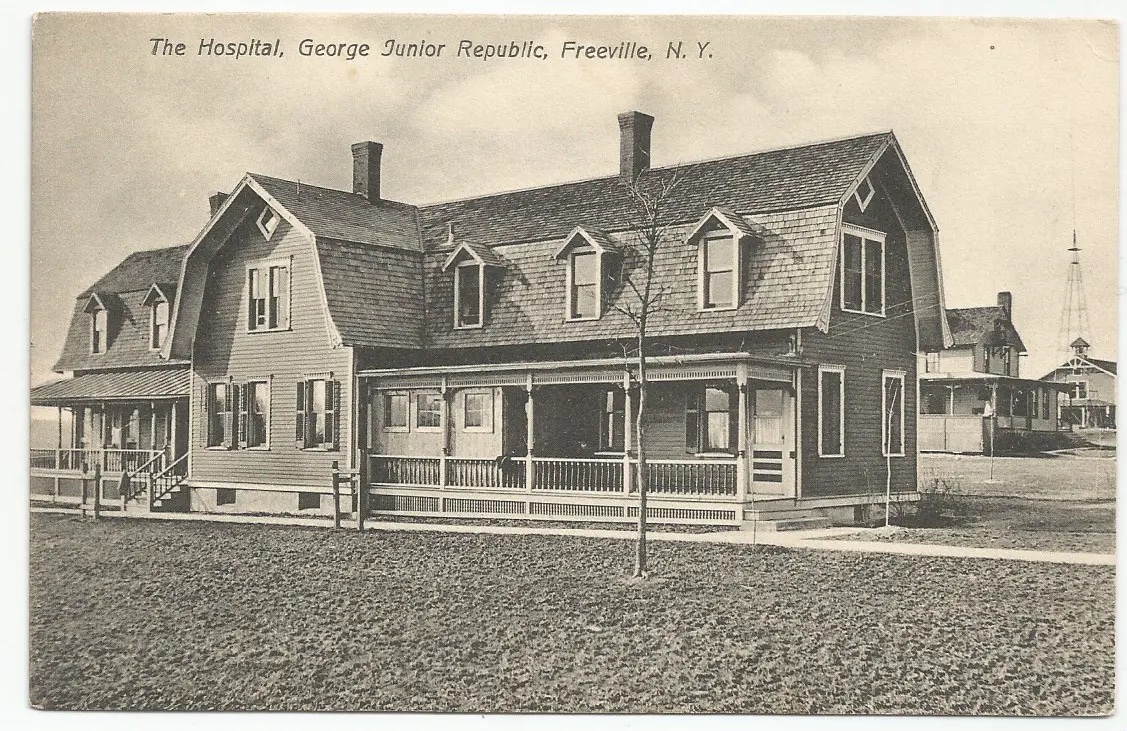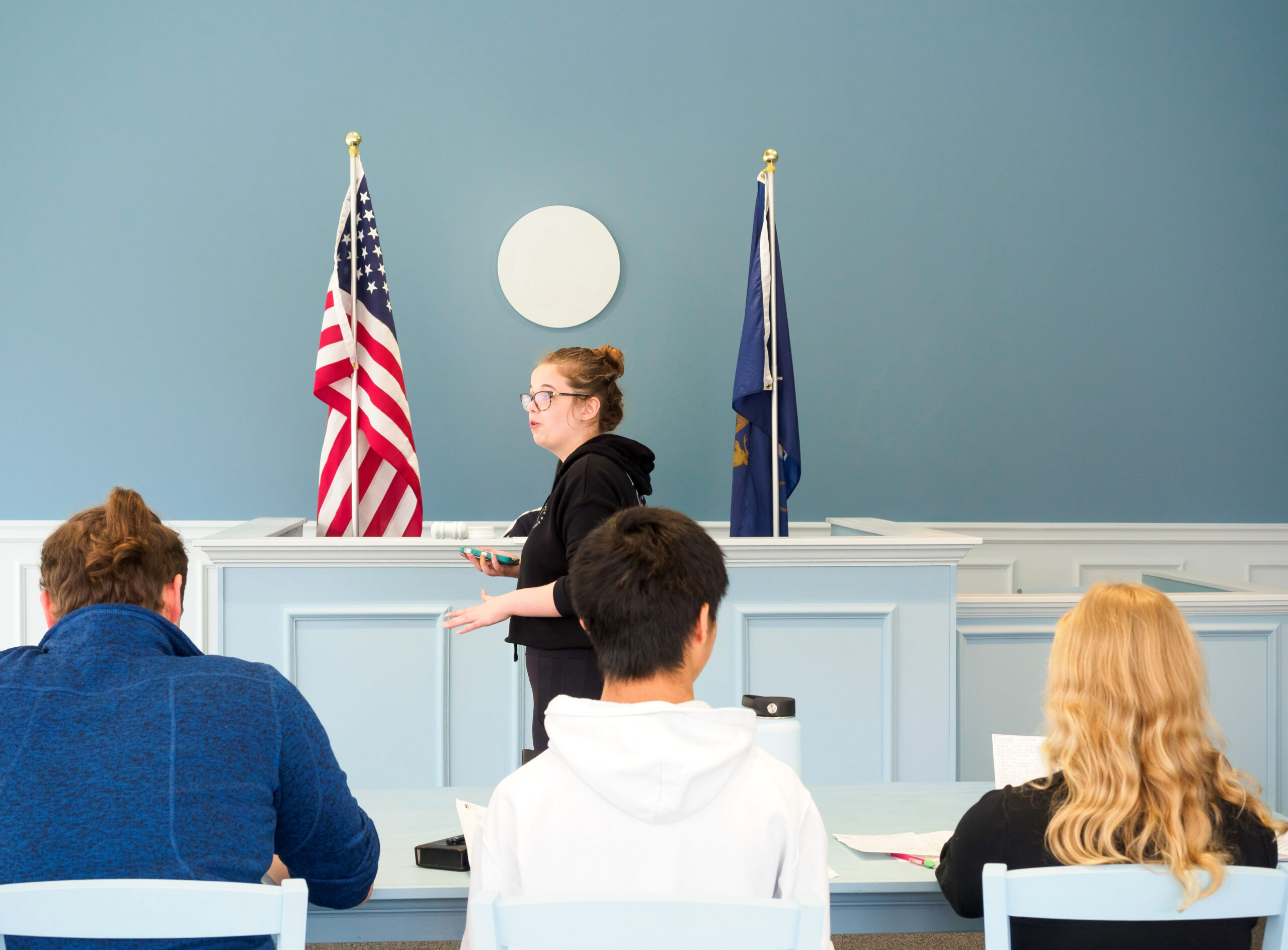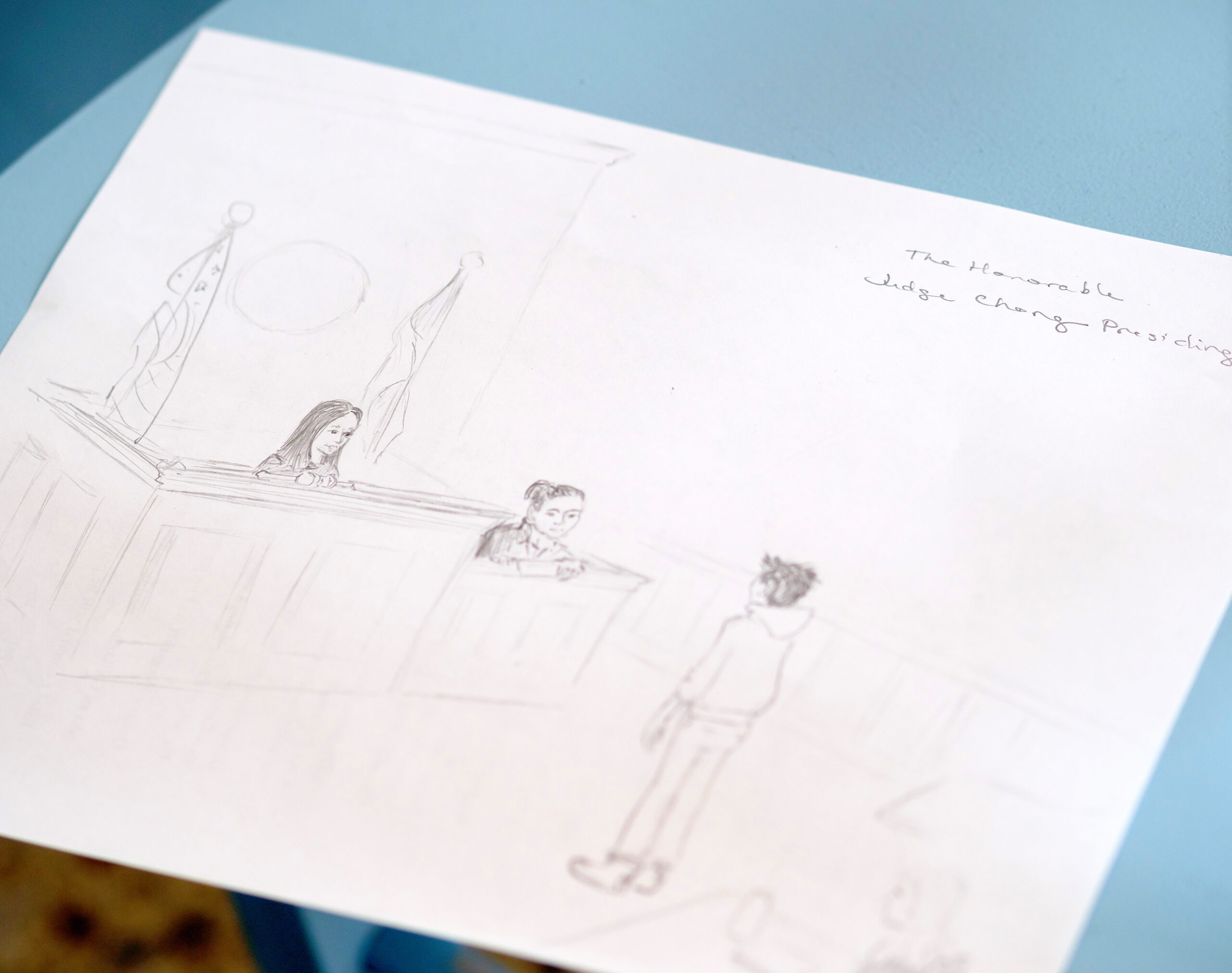Larping Adulthood: Freeville to Midlands
Share:
At my elementary school, we maintained a post office, participated in kids’ voting, and took a lesson in free market capitalism by creating a product and selling it to classmates. Today, schools continue to host programs, events, and clubs that allow children to try on adulthood. Whereas adulthood is now associated with age, maturation, and development, the effects of adulthood, agency and responsibility, weren’t defined by age. Then and now, “grown up” expectations and privileges can be bestowed, doled out, or rejected in big or small doses. What I recall from these early experiences is how real it all felt.
In my art practice, I’m fascinated by the advent and application of educational simulations. Simulation can take many forms, but it always performs imitation with an investment in outcomes. The imitation is charged by the dedication and curiosity of its performers. Divergent from the operation of theater, simulation performers, or activators, are often also the primary audience—with the goal of gaining skill or knowledge through the experience. Curator Robert Blackson distinguishes simulation from past-facing reenactment: “Simulation, although similar to reenactment, differs in that it is an artificial and prescribed projection often constructed to facilitate the prediction of a future conclusion. In this way, simulation can be appreciated as a practice in service to theory.”1 It is an experiment used to anticipate and determine future events.
Simulations can take the form of technology-based training for astronauts and the military, but also include live-action roleplaying, or larping. In these social experiments and persona creations, often carried out by young people, the performances are enacted in the everyday. Children wearing a chef’s hat or a nurse’s stethoscope for dress-up are rehearsing future selves. These actions speak to ideas of selfhood, but also to cultural expectations.
For the past seven years, my research has focused on legal simulation—primarily collegiate mock trials. To date, I have worked from the following proposition: What does this gameplay tell us about collective aspirations for the law? I think it is also worthy to understand where this form of performance and play intent upon “real life” comes from, and what it says about conceptions of childhood, education, and labor.
Courtney McClellan, Witness Lab: Community High School, 2020, installation and performance series at the University of Michigan Museum of Art [photo: Mark Gjukich; courtesy of the artist]
Much of this story originates with the invention, and reinvention, of childhood itself. At the turn of the 20th century, children were deemed to be a demographic in need of consideration and protection. Eyes turned toward punitive and extractive American labor practices in factories, which disproportionally affected children of immigrants. This need was bolstered by the National Child Labor Committee, and then driven home by the arresting 1908 photographs of American child workers by Lewis Hine.2 Subsequently, the question arose: What to do with children if they are not part of the work force? This inquiry predates any national department of education. The conundrum intrigued advocates for “good government” sometimes known as the Goo Goos, which was characterized by altruism, civic participation, and social good. Wealthy “good government” advocate William R. George proposed a solution: he would fund a separatist society run by and for children.
An aside: Stories of children creating separatist societies are well traveled in literature, film, and television. From the Lost Boys of Peter Pan (1904), through Lord of the Flies (1954), to contemporary television representations such as The Society (2019) and Yellowjackets (2021), the premise is ripe for imagination. Such stories tend to follow a familiar trajectory. These grownup-free worlds are momentarily utopian, then swiftly dystopian, as the children confront the “adult” traps of power and responsibility. Yet, these thought experiments have been limited to page and screen. More than a century ago, George piloted the “real world” version.
In 1895, with George’s financial backing and personal leadership, George Junior Republic was formed.3 In upstate New York, a haven for other separatist groups, the municipality of Freeville started as a summer camp. Immigrant children and young adults from New York City, ages 14 to 21, were carted out to the rural location to establish the new state. Bunks were provided as the children helped construct buildings, tend gardens, and make their own clothes.4 Participants were also tasked with the adjudication of disciplinary hearings for one another.5 Realism was prioritized. Early months at the Republic were challenging, but the hardship was believed to be an important aspect of the experience, even mirroring the difficulties of life in early American colonies.6 Despite the hurdles, participants proceeded to elect leaders and write laws. As the town’s name suggests, freedom and autonomy were prized but had to be initially bestowed by George, who oversaw the project and served as the first and only adult president.
General View of George Junior Republic
The language used to describe the new municipality was telling. The terms “experiment” and “workshop” were used frequently.7 The Republic was also called a “factory” and a “laboratory,” particularly in relation to developing skills of democratic citizenry. George himself called the Republic a “system of emulation,” demonstrating his belief that life in the community provided some pull-yourself-up-by-your-bootstraps skills that emboldened the children to learn to help themselves.8 The terms “miniature” or “model” connected the project to a broader cultural fascination with approximate experiences.9The Junior Republic was a surrogate space, pointing to but differentiated from the national government or, as it was called, the “Big Republic.”10All the commonly used terms served simultaneously to acknowledge and erode artifice, and to authenticate the new state.
Terminology speaks to intention. In line with Goo Goo goals, the mini-republic intended to develop participants’ “character.”11Character, here, connotes respectability, politeness, self-reliance, and obedience. Patriotism and puritanical insistence on hard work were also signified. Later, as the project grew, oligarchs John Rockefeller and Andrew Carnegie developed an interest in Freeville. They saw the program as a means to indoctrinate the principles of capitalism as a means to quash labor unrest.12Fundamentally, the experiment served to spread native-born, White, agrarian, middle-class values to immigrant children. The actuality of the Junior Republic experience for participants was affected by their individual class, race, gender, religion, and nationality.13
Contested “Big Republic” topics, such as women’s suffrage, played out in the contained world of the Junior Republic.14The simulation space offered the possibility for different outcomes from the stymied national dialogue, as women in the US paid taxes but did not have the right to vote at the time. Likewise a point of contention within the Junior Republic, girls were openly frustrated with their lesser status. Subsequently, the young women of Freeville lobbied for, and ultimately won, the right to vote. A girl senator was elected that first summer.
Within a year, at the urging of some of its most invested citizens, the Junior Republic became a year-round endeavor. The full-time residents dedicated their time to ratifying laws and improving the grounds. Jakey Smith, a Freeville citizen, was elected the first young-person president in winter 1886–1887.15 Subsequently, George took on the role of superintendent.16At that stage, Freeville was a self-sustaining society that mirrored the offerings and ills of the American experiment. It had schools, churches, businesses, and a legislature.17Participants worked at and patronized zoos, museums, and swimming pools. Freeville media encompassed a radio station, as well as a newspaper, the Junior Citizen, which started in 1898.18Participants paid taxes and took civil service exams. They stayed in hotels that imitated luxury operations, like the Waldorf in New York.19They went to the bank and the post office. They performed manual labor. They took odd jobs such as polishing shoes. Citizens banded together and created cooperative charities to help others in need and cared for one another in the hospital.20
Also, though, the society was often punitive. A team of child police made arrests when laws were violated. These laws were not mere customs or suggestions. Such violations as petty theft or smoking could lead to sentences including jail time or forced labor. Prisons were believed to be fundamental to the experiment. As George saw it, if young people experienced Freeville’s prison, they would be less likely to find themselves incarcerated in the “real world.”21Many young participants hoped to serve as officials of the court and took a bar exam to do so.22A visiting reporter praised the seriousness of the courts in Freeville: “In the open court, over which a judge of sixteen was presiding with impressive seriousness and dignity … you often see with surprise a courtliness toward one another as well as to the adults, and listen to a purity and choice of language not to have been anticipated from children of their antecedents.”23
A Court Scene in George Junior Republic [photo by Verne Morton]
George attempted to intervene in the model as little as possible. Initially, skilled, semiskilled, and unskilled labor were differentiated and came with citywide pay rates.24The right to own and manage a private business was auctioned off by George.25Controversy ensued when some wealthy citizens bought the contracts and then hired other children at a much lower wage to labor in their new businesses. Additionally, an import tax was imposed upon those who attempted to bring in supplies from the nearby town.26After complaints, George stepped in and returned to the previous wage scale with the intent of limiting the concentration of wealth.27
The Junior Republic appealed to a turn-of-the-century cultural fervor for replication that continues today.28The high-speed camera shutter, created by Eadweard Muybridge in 1878, allowed for greater documentation and dissemination—technology that led to panoramas and moving images—which further offered a means to re-create, collect, and share. The “real”—or, better yet, the “almost real”—held new currency. Such technological revelations in photographic duplication ran parallel with advances and interest in live duplication and simulation.29The 1893 World’s Columbian Exposition in Chicago included an array of replicated interactive experiences. The world was rapidly re-creating itself, and the Junior Republic’s ethos, parameters, and bylaws were believed to be viable for replication. Simulations were valorized for their approximation of reality and, like an image, were promoted as easy to re-create, portable, and viable for dissemination. Because the Junior Republic provided ideology and rules, one needed only land and child participants to grow their own republic.
With this replicability in mind, George took the program on the road with the intention of creating outposts and colonies. Proselytizing the social benefits of the Junior Republic, George and President Smith shared the success of the laboratory and encouraged similar initiatives.30Initially resistant to creating Freeville outposts, George came around to the idea after observing that other child society adaptations popped up without his consultation. Carter Junior Republic in Renderington, PA, and Boston’s Farm School are just two examples. Additionally, the practice spread to schools. School City, and then School Republic, expanded the reach of this idealization of duty and orderliness for young people.31
The Courthouse and Jail of George Junior Republic
In States of Childhood: From the Junior Republic to the American Republic, 1895–1945, scholar Jennifer Light argues that these child societies and professional simulations created a double life for children.32 These children were playing, learning, and developing while also acting as miniature adults tasked with social contribution and responsibilities. Light, who articulates her research area as “smart people’s bad ideas,” describes the Junior Republic as an inflection point in the understanding of child labor. As a transitional space between child workers of the 1800s and the protected childhood of the 1950s, these self-governing child societies were a repackaged form of labor that went uncompensated and underacknowledged. Child citizens provided necessary care for one another. Subsequently, it is difficult to parse what is “work-like” from what is work itself.
Light concludes that the child society, though disbanded, did not disappear from American life. Instead, it was reformulated or diffused into schools and public programs. 33 In the 1930s, no longer intent upon mirroring adulthood, American youth programs instead employed the language of education and training.34 When not expected to maintain a double life, young people joined a separate sphere, away from adults, where children would have physical and psychological space all their own.35This fracture provided the basis for what would become the “sheltered childhood” of the 1950s. Continuations of these ideas in school settings included home economics and Reserve Officer’s Training Corps (ROTC).36Outside educational institutions, these practices were foundational to youth organizations with strong civic ties, such as Boy Scouts, Girl Scouts, and the YMCA, as well as orphanages and reformatories.37 In place of “republics,” these groups stepped in to modify behavior and inculcate the value of duty by providing the means to mimic adulthood. Like the Junior Republic, these organizations’ practices promoted independence, while also paradoxically foregrounding obedience. What is more responsibility laden than the Boy Scout/Girl Scout motto, “Be prepared”?
I agree with Light that youth civic simulation did not cease with the Junior Republic, and I see a renewed interest in it today. Mock Trial and Model United Nations picked up the mantel and added a rhetorical and theatrical flair. Even government programs such as Boys State and Girls State—state-run democracy experiments for high schoolers, and the subject of a compelling 2020 documentary—continue this lineage of serious play. Young people practicing democracy in these closed forums further the relentlessly independent spirit and tactical drive of the Junior Republic.
Courtney McClellan, Witness Lab: Community High School, 2020, installation and performance series at the University of Michigan Museum of Art [photo: Mark Gjukich; courtesy of the artist]
In mock trials, students shape all aspects of a legal case by performing the roles of attorneys and witnesses. The practice ranges in age and experience level, from law school mock trial and oral arguments—whose aims are developing litigation skills—to elementary school mock trial that professes character building, as in George Junior Republic. Often, elementary mock trial includes an added layer of fantasy because the cases are set within fairy tales.38 For instance, these beginners might adjudicate an alleged case of trespassing by defendants Hansel and Gretel or argue a case in which Goldilocks faces burglary charges.
I am most acquainted with American collegiate mock trial, a program that began in 1985.39 It follows a trend within law schools, and beyond, that asserts practical skills, as opposed to theoretical knowledge, should be taught at universities. Students typically ranging in age from 18 to 22 engage in this form of collaborative storytelling. More than 400 colleges in the US compete in regional and national tournaments. In competition, students act out the details of shared fictional cases, at varying times arguing for the prosecution or the defense.
All collegiate mock trial cases are set in the fictional state of Midlands, which sounds like a sister city to Freeville. Like Freeville, Midlands is filled with dichotomies pointing to judicial aspirations and failings. Although not occupying a physical space, Midlands is pervasive and frequently invoked in each trial. Midlands has its own procedures and unique bylaws, but it defaults to US federal law unless otherwise specified. Further blurring the truth/fiction boundary, many case storylines come from real trials. Curiously, Midlands trials both uphold and diverge from the actual practice of law. For instance, as in US federal law, Midlands presumes equality for participants, yet outcomes offer little evidence of that equity. The race, gender, or ethnicity of characters in mock trial narratives go undefined—allowing any person to play any part—but in doing so, remove the most prejudicial aspects of the real legal system.
Having observed hundreds of hours of mock trial myself, I find those moments of close imitation and fantastical leaps to be the most compelling ones. Mock trial participants regularly tell a story of authority and authenticity—yet many of them adopt Broadcast English. I recall a student no more than 20 years old who changed his vocal cadence while performing as a Midlands attorney. His speech deepened and slowed. He even employed a Bill Clintonesque tone and stance to drive home his closing argument.
Moments of play and absurdity draw attention to the adaptability of the format. I attended the 2016 Mock Trial National Championship at Furman University in Greenville, SC. Yale won the competitive tournament, which came with little surprise, because of the school’s lauded theater program. On the stand, a Yale witness who, in character, claimed to be a performance artist, gestured wildly when announcing that she had glued her hands together for an upcoming stunt. In such playful moments, artifice authenticates the simulation.
Whether true to reality or “jumping the shark,” mock trial and the Junior Republic speak to desires for the American democratic experiment, while also influencing it. As time passed, Freeville changed to address growing educational and welfare expectations, and it was altered again after George died in 1936.40 But by that time, the message preached by the Junior Republic had spread. The influence of mock adulthood can still be seen in education today. Former child citizens went on to participate in the worlds of finance, law, and government. The same is true for mock trial, as many of its participants become actual lawyers. Midlands served as the first jurisdiction for these now-influential figures.
Educational simulation rejects the abstract and the theoretical in exchange for the real and the concrete. The lived knowledge created there often reinforces what already exists. The impact is undeniable: Simulation, in this form, perpetuates the stratification and limiting ideology already found in society. Could educational simulation rewrite, reframe, or create anew? What would that look like? And how might the “Big Republic” learn from the child-run model? Simulations depend upon the past but—as Blackson states—diverge from reenactment because they are not mere re-creation. With intervention, outcomes change. A radical reimagining of the laboratory of youth civic simulation might beget new societies.
Courtney McClellan, Student Sketch of Witness Lab: Community High School, 2020, installation and performance series at the University of Michigan Museum of Art [photo:Mark Gjukich; courtesy of the artist]
Courtney McClellan is an artist, writer, editor, and educator living in Atlanta, GA. Her work has been shown at museums and exhibition spaces like SculptureCenter in Long Island City, NY (2018); the University of Michigan Museum of Art in Ann Arbor, MI (2020); and the Museum of Contemporary Art of Georgia in Atlanta, GA (2021). McClellan has been awarded fellowships at the Library of Congress and the University of Michigan, and her practice has been supported by residences at McDowell, Yaddo, the Hambidge Center, and Stove Works. Her work has been written about in Art in America, The Brooklyn Rail, and the Atlanta Journal Constitution.
McClellan is the Editor at Burnaway, a non-profit magazine of contemporary art and criticism from the American South and the Caribbean. Recently, her essay “Putting Words in Your Mouth and Images in Your Eyes” was published in Ventriloquism, Performance, and Contemporary Art (Routledge 2023), a volume edited by Dr. Jennie Hirsh and Dr. Isabelle Loring Wallace.
References
| ↑1 | Robert Blackson, “Once More … With Feeling: Reenactment in Contemporary Art and Culture,” Art Journal 66, no. 1 (2007): 30. |
|---|---|
| ↑2 | “National Child Labor Committee Collection,” Library of Congress. online. https://www.loc.gov/pictures/collection/nclc/background.html |
| ↑3 | Jennifer Light, States of Childhood: From the Junior Republic to the American Republic, 1895–1945 (Cambridge: MIT Press, 2020), 10. |
| ↑4 | Light, States of Childhood, Ibid., 36. |
| ↑5 | Ibid., 24. |
| ↑6 | Ibid., 43. |
| ↑7 | Ibid., 38. |
| ↑8 | Ibid., 33. |
| ↑9 | Ibid., 10. |
| ↑10 | Ibid., 2. |
| ↑11 | Ibid., 35. |
| ↑12 | Ibid., 46. |
| ↑13 | Ibid., 5. |
| ↑14 | Ibid., 26. |
| ↑15 | Ibid., 31. |
| ↑16 | Ibid., 30. |
| ↑17 | Ibid., 1. |
| ↑18 | Ibid., 29. |
| ↑19 | Ibid., 28. |
| ↑20 | Ibid., 37. |
| ↑21 | Ibid., 42. |
| ↑22 | Ibid. |
| ↑23 | Ibid., 33. |
| ↑24 | Ibid., 26. |
| ↑25 | Ibid., 28. |
| ↑26 | Ibid., 30. |
| ↑27 | Ibid. |
| ↑28 | Ibid., 40. |
| ↑29 | Ibid. |
| ↑30 | Ibid., 31. |
| ↑31 | Ibid., 56–58. |
| ↑32 | Ibid., 2. |
| ↑33 | Ibid., 3. |
| ↑34 | Ibid., 27 |
| ↑35 | Ibid., 4. |
| ↑36 | Ibid., 3 |
| ↑37 | Ibid., 2. |
| ↑38 | “Fairy Tale Trials,” Community Services. Monroe County Bar Association, http://www.monroebar.org/index.cfm?e=inner3&itemcategory=59420 |
| ↑39 | “History of AMTA,” The American Mock Trial Association, https://www.collegemocktrial.org/about-amta/history- |
| ↑40 | Light, States of Childhood, Ibid., 15. |
